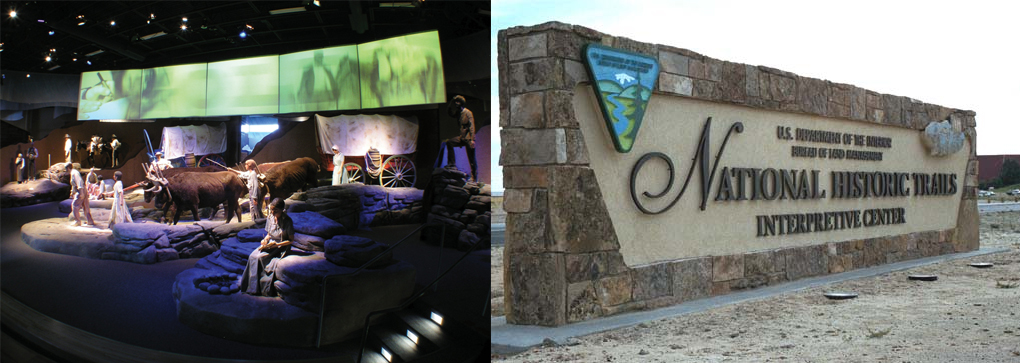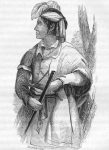If you ask Fred what were some of his more memorable projects, he would definitely mention the following – The National Historic Trails Interpretive Center, Coacoochee’s Story Theater, Interactive Learning Studio, Seacoast Science Center… and more.
The National Historic Trails Interpretive Center in Casper, Wyoming.
Although the Orientation Theater with six synchronized videos with programmed lighting effects on the dioramas and 12 channels of audio is impressive, he takes the most pride in the simulated North Platte River crossing in a covered wagon experience. This exhibit combines a wagon big enough for approximately six visitors to ride in, a hydraulic system for motion, enhanced feeling audio and fantastic three segment video produced by Boston Productions Inc. to create a unique and memorable visitor experience. Click on the image to see some short video clips of this project.
 Coacoochee’s Story Theater, Tampa Bay History Center, Tampa, Florida.
Coacoochee’s Story Theater, Tampa Bay History Center, Tampa, Florida.
Although this is one of Fred’s more recent projects, it is challenging the front runners as one of his top two favorites. This project is a unique presentation of the story of a Seminole Chief during the Seminole Wars in the 1800s. The audience’s initial view is from a tree shaded canopy overlooking Tampa Bay, circa the 1800s, with a large video screen nested up in the trees and Spanish moss hanging from the limbs. The Bay Scene was painted on a scrim which separates the static foreground from the dynamic scenes behind. Behind the scrim are three motorized turntables (from 14 to 18-feet in diameter) and a very large video screen. The center turntable is partitioned for three scenes while the other two turntables each sport two scenes and a video projector and vertical screen for presenting larger than life videos of the key characters. Diorama scenes include Coacoochee chained on a ship, Lt Sprague both writing at an encampment and in full ceremonial uniform (dress blues), Coacoochee and Osceola in a prison cell and an attacking Indian in the woods bordering Lake Okeechobee. The sixteen minute plus show has elaborate lighting effects which included strobes for rifle shots in battle scenes to a blazing inferno in the theater during fire scenes. All-in-all, the show is a powerful and creative presentation of a very moving story, once again developed through the creative vision of Bob Noll and Boston Productions. The control program synchronizes the mpeg videos with the lighting program; provides automated playing twice or three times an hour (based on user selection) or on demand in a manual mode. The show control also cues the table movements as well as provides safety measures for the eight-ton platforms and controls the theater entry and exit doors. It also controls the countdown to next show video outside the theater and provides a scheduler for automated power up and down on a daily basis using user input for times. Finally, it provides Fire Alarm initiated shut down as well as user activated emergency operations. We hope to add more pictures in the future.
Interactive Learning Studio, Seacoast Science Center in Rye, New Hampshire.
The challenge for this three video show that has the docent faux “real time” interaction with three teams exploring the Gulf of Maine environment was the ambitious light show. It was comprised with three moving lights, four stationary gobos, eight gobos in a moving light fixture, changing color gels and a grand finale. Each visitor is at one of 32 computer stations. During the show they answer questions, play games and try to help each of the three teams on the screens. Near the end, the PCs determine which of the 32-stations has the highest score. The show program then starts a 15-second search light sequence trying to find the winner. Finally all lights converge on the winner’s position and their live image is switched to the center screen. Once again, Boston Productions did a great job on both the videos and the interactive computer experience.
Down Hill Mountain Bike Experience at the Carnegie Sportsworks Exhibit in Pittsburgh, Pennsylvania.
Fred developed the specification for the servo driven platform supporting the three visitors on their mountain bikes and programmed the show control that also incorporated a large screen projection system and a resonating audio system.
“Give Me Freedom Puppet Show”, Price of Freedom Gallery, Smithsonian National Museum of American History.
Although Fred’s prior Armed Forces commitment made him put his all into the entire gallery, this three scene, rotating stage, animated puppets and props exhibit was by far the most challenging. It demanded extended hours of effort, custom electronics and innovative NetLinx programming routines to accomplish. It also required a custom multi-joystick control console to record the two puppeteers’ performance that enabled Fred to manually adjust the data to ensure puppet motion would never overextend the mechanical limits during automated playback. The “Rosie the Riveter” interactive in this gallery was also great fun.
The Civil War Museum at Historic Tredegar, Richmond, Virginia.
The fun challenge for this museum gallery was the interactive voting theater that took the audience’s votes and, in real time, combined them with all prior audiences votes and displayed them within the video on the center screen during the show.
 The Challenger Space Simulator for the Challenger Center for Space Education, Headquarters in Alexandria, Virginia.
The Challenger Space Simulator for the Challenger Center for Space Education, Headquarters in Alexandria, Virginia.
Fred designed and delivered the electronic systems for 24 of the Second Generation Space Simulator all over the United States and one in the United Kingdom. It consisted of a “Houston” control room and a Space Lab that was capable of “suspending disbelief.” It used six “fixed” cameras, two pan-tilt cameras, 22 Mac PCs, over 48 TV and PC monitors, an Autopatch switcher, DVD player, tape decks and CD players. Fred modified and tested the unit that was deployed to England for 50Hz power and the European video standard (PAL) before the unit was shipped out of the U.S. The deployment of 24 systems spanned ten years and most are still in operation today. Click on image to see more of the Challenger Learning Center Space Simulator.
To see a curriculum vitae that lists all the projects Fred has been involved with over the last sixteen years click on the link that follows. Remember for each project, he either project managed, designed or programmed (and sometimes all three). And for all of them, he ultimately ensured that the project was delivered satisfactorily to the end client.
